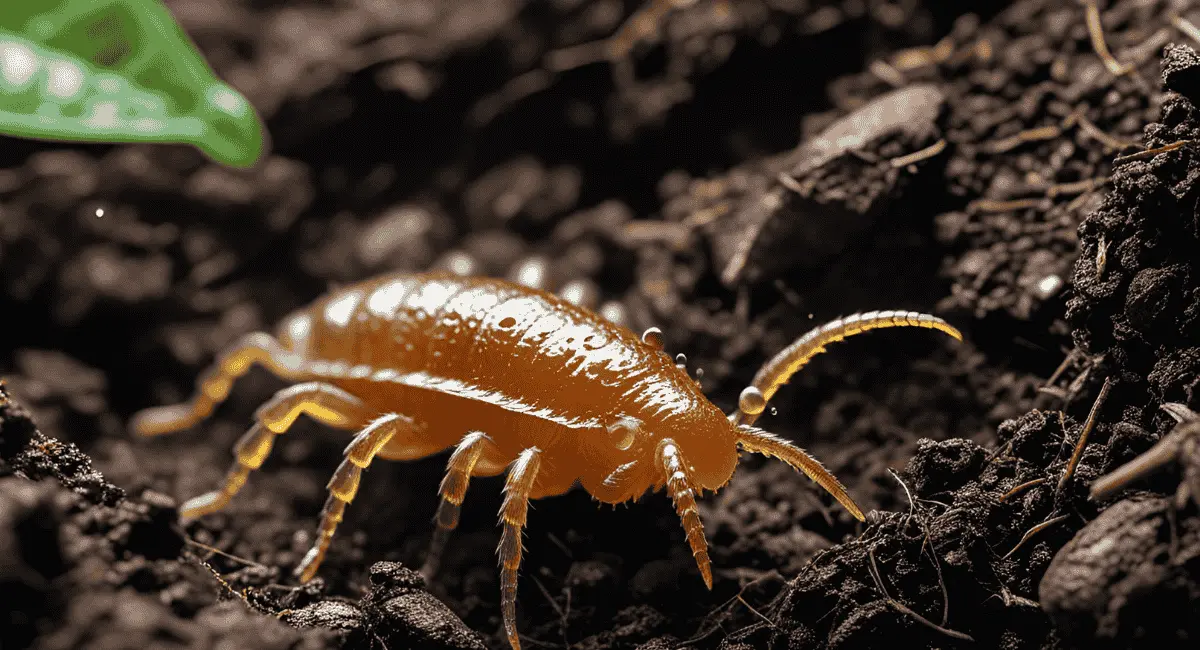Table of Contents
Soil mites are tiny critters living in your soil whether it’s your backyard garden, compost pile, or houseplant pots. It’s common for folks to worry when they spot something crawling in the dirt. But as a long-time gardener, let me walk you through what these little bugs are all about, and why they’re not usually a reason to panic.
What Are Soil Mites?
Soil mites are tiny arthropods commonly found in compost, potting soil, and garden beds. They play a role in breaking down organic matter.
Soil mites are very small bugs that live in the top layer of your soil. They often look like slow-moving white or tan dots. You’ll usually see them when watering your plants or digging in the dirt. They’re part of the natural crew of organisms that live underground, much like earthworms or helpful fungi.
Most soil mites feed on decaying leaves, mold, fungi, and other broken-down matter. Basically, they’re recyclers. They help turn organic waste into nutrients your plants can use. Most of the time, they’re working behind the scenes and you won’t even notice them.
Are Soil Mites Good or Bad for the Garden?
Honestly? In the garden, they’re more good than bad.
Soil mites help break down compost and old plant material, which boosts soil health. They support beneficial microbes and fungi, which in turn help your plants grow stronger. I like to think of them as nature’s cleanup crew. If you see a few in your garden soil, that’s usually a sign you’ve got rich, living earth under your feet.
Do Soil Mites Hurt Plants?
In most cases, soil mites are not harmful. They help decompose organic material and support healthy soil ecosystems. However, very high populations might indicate excessive organic decay or poor soil balance.
Soil mites don’t chew on live roots or leaves. They stick to stuff that’s already dead or breaking down. Some folks confuse them with more harmful bugs, like spider mites or root aphids, but they’re not the same thing at all. If anything, they help your plants by improving the soil.
Are Soil Mites Harmful to Humans or Pets?
No, soil mites do not bite humans or pets. They feed on fungi, algae, and decomposing matter, not living tissue.
You don’t need to worry about soil mites biting you or your pets. They don’t sting, they don’t carry diseases, and they don’t cause harm.
Now, these aren’t the same as dust mites, which can bother people with allergies. Soil mites stick to the dirt and don’t float around your home. If you have a big infestation and are sensitive to allergens, you might want to clean things up a bit. But generally speaking, they’re harmless roommates.
Can Soil Mites Become a Problem in Houseplants?
Sometimes, yes especially if things get out of balance.
If you’re overwatering or using really rich compost indoors, soil mites can start to multiply. If you’re seeing a lot of them and your soil smells funky or looks moldy, it’s a sign the environment is too damp and rich for an indoor setting.
I’ve had this happen in potted plants before. The fix? Let the soil dry out, scrape off any moldy bits, and maybe repot if things look really messy.
Why Do Soil Mites Show Up?
These bugs show up when the conditions are just right for them.
They like warm, moist soil with lots of organic matter to munch on like mulch, dead leaves, or unprocessed compost. If your soil is rich and hasn’t dried out in a while, that’s the perfect home for soil mites.
It doesn’t mean anything’s wrong it just means the soil is active and alive.
How Can You Identify Soil Mites?
Look closely at your soil. If you spot tiny white or tan specks moving slowly across the top layer, you’ve probably got soil mites.
They’re much smaller than pests like gnats, and they don’t fly or zip around. Try using your phone’s camera on zoom or a magnifying glass to get a better look. You’ll often see them near bits of compost or under leaf litter.
Are They the Same as Fungus Gnats or Spider Mites?
No, and it’s important to know the difference.
Here’s a quick guide to tell them apart:
| Bug Type | Harm Plants? | Lives in Soil? | Visible Movement |
| Soil Mites | No | Yes | Slow-moving |
| Fungus Gnats | Larvae do | Yes | Flying bugs |
| Spider Mites | Yes | No (on leaves) | Very tiny |
| Root Aphids | Yes | Yes | Medium speed |
Soil mites are your friends. The others? Not so much.
Should You Get Rid of Soil Mites?
If they’re not causing visible damage or spreading to unwanted areas, there’s usually no need to remove them. If you’re concerned, improving soil drainage and reducing excess organic matter can help control their population.
Most of the time, I’d say leave them be.
You might want to act only if they’re spreading in big numbers indoors or if your soil is staying too wet and starting to smell. If you’re allergic to soil mites or don’t want them indoors, it’s okay to manage the situation. But if they’re out in your garden or compost pile, let them do their thing.
How to Get Rid of Soil Mites Naturally
If you really want to reduce soil mites, here’s what I usually recommend:
Let your soil dry out between waterings. They hate dry conditions. Sprinkle some cinnamon on top—it naturally fights off mold and discourages mites. Neem oil spray works great too, and it won’t hurt your plants. You can also repot the plant with fresh soil if things look really off. Just make sure to clean the pot first and improve drainage if needed.
Skip the chemical stuff your plants and soil life will thank you.
How to Keep Soil Mites from Coming Back
Once you’ve got things under control, keeping soil mites away is easy:
Use clean potting mix when repotting. Don’t overwater. Let the top layer of soil dry out before adding more moisture. Keep your indoor pots tidy—don’t let dead leaves or soggy bits sit too long. For outdoor gardens, just let nature balance itself.
Soil mites will always be part of a healthy garden, and that’s something to be proud of.
Final Thoughts: Are Soil Mites Really Bad?
As someone who’s spent years digging in the dirt, I can tell you—soil mites are more helpful than harmful. They’re part of a healthy soil system and usually nothing to worry about. In fact, they’re one of the signs your soil is alive and working just the way it should.
Unless they’re swarming your houseplants or causing mold problems, there’s really no need to get rid of them. Let them do their job and your plants will thank you for it.


